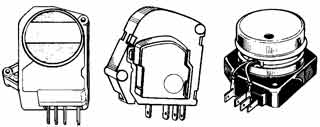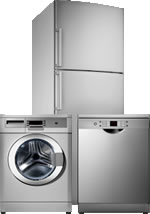How To Test the Defrost Timer
A mechanical defrost timer controls the defrost cycle of the freezer. In older models, the timer runs continuously and roughly every six hours, cuts power to the cooling system and sends power to the defrost heater. In newer models the timer advances only while the compressor or defrost cycle is running - an improvement for efficiency. As the timer continues to advance, power to the heating element is cut and power is restored to the cooling system. If the timer does not advance, the appliance will be stuck either in defrost or refrigerate mode, resulting in, respectively, no cooling or frost build-up.
Caution: Please read our safety information before attempting any testing or repairs.
 Before testing the defrost timer, unplug the refrigerator to avoid an electrical shock hazard.
Before testing the defrost timer, unplug the refrigerator to avoid an electrical shock hazard.
The defrost timer is usually found behind the front grill "toe kick" of the refrigerator. It may also be found behind a cover plate inside the refrigerator or freezer, in the temperature control console, or behind the refrigerator near the compressor.
To test whether the defrost timer is simply failing to advance, locate the advance screw and turn it clockwise until you hear it click. This advances it to the next mode. If it was cooling before, it is now in defrost mode. Simply wait about 35 minutes and check whether it has left defrost mode and has resumed cooling (listen for the compressor). If it does not advance, the timer motor is probably bad and the entire timer needs to be replaced. If it advances as it should, then you can follow the steps below to test the switch electrically.

The timer is usually held in place with one or more screws. Remove the screws and gently pull the timer out far enough to disconnect the wiring connector. The connector can be removed by firmly pulling and rocking it left and right. It is not necessary to note the position of the wires because the connector plug is keyed so that it can be replaced in only one way.
Test the timer for continuity using a multitester. Set the multitester to the ohms setting X1. The timer has four terminals. Locate the common terminal, it should be labeled "3" or "C". If the terminals are not labeled, determine which terminal coincides with the white wire in the connector plug.
Once you have located the common terminal, touch one probe to it. Touch the other probe to each of the three remaining terminals. The multitester should display a reading of zero or near to zero ohms (which indicates continuity) for one pair of the terminals and possibly two pairs. The third pair of terminals should show no continuity (infinity).
Locate the timer switch and turn it clockwise until you hear it click. Now retest the timer as you did above. One pair of terminals should indicate continuity (possibly two pairs). At least one pair should give a reading of infinity. Note however, one of the pairs that showed continuity in the first test should now read infinity and one pair that read infinity should now show continuity. If the defrost timer does not pass these tests, it is likely that it should be replaced.
* We have received two reports of cases in which only one pair of terminals shows continuity and when the timer is advanced, the same pair still shows continuity. For these isolated cases, this was reported to be the correct operation of the timer. At this time we have not been able verify this case. This may indicate a specific model or models that use a different wiring configuration than discussed in this article. Also, note that this article applies to mechanical defrost timer controls and not electronic or adaptive defrost controls.





